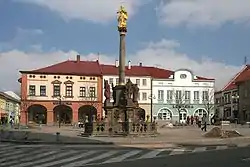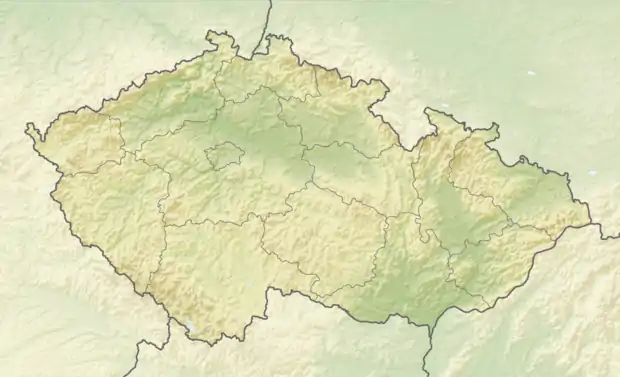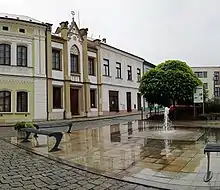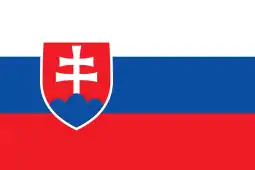Dobruška
Dobruška (Czech pronunciation: [ˈdobruʃka]; German: Gutenfeld) is a town in the Hradec Králové Region of the Czech Republic. It has about 6,700 inhabitants. The town is known as the birtplace of Czech patriotic writer František Ladislav Hek, whose career was described in Alois Jirásek's novel F. L. Věk. The town centre is well preserved and is protected by law as an urban monument zone.
Dobruška | |
|---|---|
 Marian column in the town square | |
 Flag  Coat of arms | |
 Dobruška Location in the Czech Republic | |
| Coordinates: 50°17′33″N 16°9′45″E | |
| Country | |
| Region | Hradec Králové |
| District | Rychnov nad Kněžnou |
| First mentioned | 1320 |
| Government | |
| • Mayor | Petr Lžíčař |
| Area | |
| • Total | 34.44 km2 (13.30 sq mi) |
| Elevation | 287 m (942 ft) |
| Population (2021-01-01)[1] | |
| • Total | 6,651 |
| • Density | 190/km2 (500/sq mi) |
| Time zone | UTC+1 (CET) |
| • Summer (DST) | UTC+2 (CEST) |
| Postal code | 518 01 |
| Website | www |
Administrative parts
Villages of Běstviny, Chábory, Domašín, Křovice, Mělčany, Pulice and Spáleniště are administrative parts of Dobruška.
Geography
Dobruška is situated in the Orlické Mountains valley, about 140 kilometres (87 mi) east of Prague. It lies on the confluence of two watercources, river Dědina (also called Zlatý Brook) and Brtevský Brook.
History
The predecessor of Dobruška was a market settlement Lešno, located on the crossroads of two trade routes. The first written mention is from 1320. In 1495, with the arrival of the noble family of Trčka of Lípa, the town began to develop. The houses were reconstructed in the Renaissance style and a representative town hall was built. The prosperity and importance of the town ended with the Thirty Years' War.[2]
The large fires in 1806 and 1866 damaged Dobruška and the reconstructions changed the character of the town. At the end of the 19th century, the industry developed, especially the textile industry. In 1908 Dobruška was connected with Opočno by railway.[2]
Economy
The Military Geographical and Hydrometeorological Office is located in Dobruška.
Culture
The International Music Festival of F. L. Vek is organized in Dobruška.
Sights

The historic centre is formed by F. L. Věka Square and adjacent streets. Its main landmark is the Renaissance town hall with a 45 metres (148 ft)-high tower. In the tower there is the town museum and gallery with early works of F. Kupka. In the middle of the square is a Marian column from 1733.[3]
The Church of Saint Wenceslaus was first mentioned in 1350. Its part is an early Baroque belltower. The cemetery Church of Holy Spirit was built in Renaissance style in the 16th century.[3]
The former Jewish synagogue in Dobruška is nowadays part of the town museum. The synagogue was originally built in the 18th century and then rebuilt in the Neogothic style in 1867 after it was damaged by a fire. There is also the Jewish cemetery with the oldest preserved tomb from 1688.[3]
Notable people
- František Ladislav Hek (1769–1847), patriotic writer
- Alois Beer (1833–1897), painter
- František Kupka (1871–1957), painter and graphic artist; lived here in 1872–1889
- Radim Drejsl (1923–1953), composer, pianist and conductor
Twin towns – sister cities
 Ábrahámhegy, Hungary
Ábrahámhegy, Hungary Hnúšťa, Slovakia
Hnúšťa, Slovakia Miejska Górka, Poland
Miejska Górka, Poland Piława Górna, Poland
Piława Górna, Poland Radków, Poland
Radków, Poland Veľký Meder, Slovakia
Veľký Meder, Slovakia
Gallery
 Aerial view of the centre
Aerial view of the centre Town hall
Town hall
References
- "Population of Municipalities – 1 January 2021". Czech Statistical Office. 2021-04-30.
- "Historie a současnost" (in Czech). Město Dobruška. Retrieved 2021-09-19.
- "Významná místa Dobrušky" (in Czech). Kulturní a sportovní zařízení města Dobrušky. Retrieved 2021-09-19.
- "Partnerská města" (in Czech). Město Dobruška. Retrieved 2021-09-19.